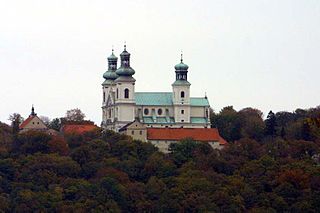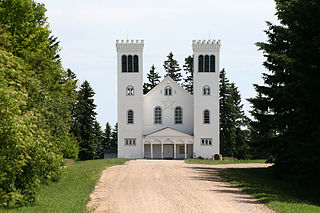Related Research Articles

A monastery is a building or complex of buildings comprising the domestic quarters and workplaces of monastics, monks or nuns, whether living in communities or alone (hermits). A monastery generally includes a place reserved for prayer which may be a chapel, church, or temple, and may also serve as an oratory, or in the case of communities anything from a single building housing only one senior and two or three junior monks or nuns, to vast complexes and estates housing tens or hundreds. A monastery complex typically comprises a number of buildings which include a church, dormitory, cloister, refectory, library, balneary and infirmary, and outlying granges. Depending on the location, the monastic order and the occupation of its inhabitants, the complex may also include a wide range of buildings that facilitate self-sufficiency and service to the community. These may include a hospice, a school, and a range of agricultural and manufacturing buildings such as a barn, a forge, or a brewery.

The Camaldolese Hermits of Mount Corona, commonly called Camaldolese is a monastic order of Pontifical Right for men founded by Saint Romuald. Their name is derived from the Holy Hermitage of Camaldoli, high in the mountains of central Italy, near the city of Arezzo. Its members add the nominal letters E.C.M.C. after their names to indicate their membership in the congregation. Apart from the Roman Catholic congregations, ecumenical Christian hermitages with a Camaldolese spirituality have arisen as well.

The Bridgettines, or Birgittines, formally known as the Order of the Most Holy Savior, is a monastic religious order of the Catholic Church founded by Saint Birgitta in 1344 and approved by Pope Urban V in 1370. They follow the Rule of Saint Augustine. There are today several different branches of Bridgettines.
In Christianity, an oblate is a person who is specifically dedicated to God and to God's service.
Fr. Augustine Baker OSB, also sometimes known as "Fr. Austin Baker", was a well-known Benedictine mystic and an ascetic writer. He was one of the earliest members of the English Benedictine Congregation which was newly restored to England after the Reformation.

The English Benedictine Congregation (EBC) unites autonomous Roman Catholic Benedictine communities of monks and nuns and is technically the oldest of the nineteen congregations that are affiliated in the Benedictine Confederation.

Huysburg is a Benedictine monastery situated on the Huy hill range near Halberstadt, in the German state of Saxony-Anhalt. The Romanesque abbey has existed since about 1080 and was secularised in 1804. A new Benedictine community was founded in 1972 and has been headed by a prior since 1984.
St Mary's Abbey, also known as Malling Abbey, is an abbey of Anglican Benedictine nuns located in West Malling, Kent, England. It was founded around 1090 by Gundulf, Bishop of Rochester.
Dame Werburg Welch, OSB (1894–1990), born Eileen Welch, was an English artist and Benedictine nun. Born in Cheltenham, her father was a Catholic convert, who sent her to convent schools. She studied art at both Southampton and Bristol, before becoming a nun, then carried on her work beyond.

Stanbrook Abbey is a Catholic contemplative Benedictine convent with the status of an abbey, located at Wass, North Yorkshire, England.
Roger Francis Crispian Hollis is the Bishop Emeritus of Portsmouth for the Roman Catholic Church.

St. Peter's Abbey is in Muenster, Saskatchewan, Canada. It is the oldest Benedictine monastery in Canada. It was founded in 1903.
Saint Mary's Abbey in Colwich, Staffordshire was a monastery of Roman Catholic nuns of the English Benedictine Congregation, founded in 1623 at Cambrai, Flanders, in the Spanish Netherlands, and closed down in 2020. During the French Revolution, the community was expelled from France and settled at Mount Pleasant, Colwich, in 1836, where it remained for the next 84 years.

East Bergholt Abbey was an abbey in Suffolk, England. It was built on land purchased in 1857 on the site of Old Hall manor.
Driana Enid Wybourne, professed as Sister Catherine Wybourne OSB, was a British Benedictine nun and prioress of Howton Grove Priory, Hereford. She was also a well-known commentator in the British media, with an internet presence as the Digitalnun.

In This House of Brede is a novel by Rumer Godden published in 1969 by Viking in the US and by Macmillan in the UK.

Catherine Gascoigne was the English abbess of Cambrai from 1624 to 1673.
References
- ↑ Benedictine Yearbook 2011, ed. Rev Dom William Wright, OSB, p.176
- ↑ Portsmouth R. C. diocese: religious communities
- ↑ "Something about Ourselves". www.benedictinenuns.org.uk. Retrieved 30 June 2018.
- ↑ "Media Menu". www.benedictinenuns.org.uk. Retrieved 30 June 2018.
- ↑ "2009 Winners". Christian New Media Awards and Conference. Archived from the original on 21 June 2010. Retrieved 17 September 2022.